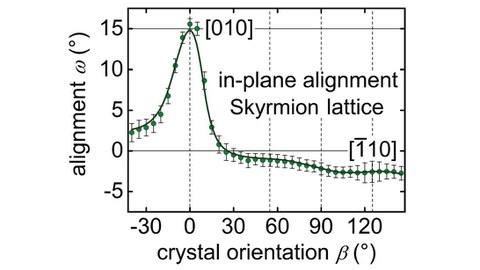Dec 21, 2018
Research: Orientation of the skyrmion lattice in chiral magnets
Magnetic skyrmions are two-dimensional topological whirls of the magnetization. They spontaneously form in chiral magnets like MnSi, FeGe and Cu2OSeO3 within the plane perpendicular to the applied magnetic field, and they extend along the field forming a line or string. These skyrmion strings condense into a hexagonal lattice similar to the Abrikosov vortex lattice in superconductors. The orientation of the hexagonal lattice however depends, in both cases, delicately on the chosen field direction.
Whereas this dependence is not yet fully understood for the Abrikosov lattice, researchers at the TU Munich and TU Dresden were able to settle this question for the skyrmions. The orientation of the skyrmion lattice is governed by weak magnetocrystalline anisotropies. The researchers succeeded to derive an effective theory for chiral magnets with space group P213 that allowed to explain extensive neutron scattering experiments on MnSi. Interestingly, the theory also predicts specific field directions for which the skyrmion lattice orientation is, in agreement with the “hairy-ball theorem”, particularly sensitive. These singular field directions, however, remain to be explored experimentally.
T. Adams, M. Garst, A. Bauer, R. Georgii, C. Pfleiderer,
Response of the skyrmion lattice in MnSi to cubic magnetocrystalline anisotropies,
Phys. Rev. Lett. 121, 187205 (2018)

